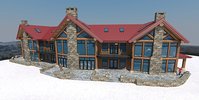By Shawn Perich

If you head south from Duluth on State Highway 23, you pass through a tiny corner of Wisconsin. Crossing the St. Louis River at Fond du Lac, you spend 15 seconds driving through the Badger State before re-entering Minnesota. This slice of land is an orphan of geography, because you can’t get there from Wisconsin. It is also the location of the venerable Mont du Lac Ski Area.
Built on the steep, red-clay hills that rise up from the river, Mont du Lac opened in 1948, making it one of the oldest ski areas in the region. In 2008, a new era began for Mont du Lac when it was purchased by Larry and Donna Pulkrebec, owners of Field Logic, an archery and sporting goods manufacturer located in Superior, Wisconsin. They embarked on an ambitious plan to revamp the area’s recreational opportunities and to build a new, hilltop lodge.
Those plans were coming to fruition, says general manager Mike Cameron, when a massive rainstorm last June unleashed a torrential flood that wiped out Duluth and nearby Jay Cooke State Park. The storm caused about 50 landslides on Mont du Lac’s clay hills, including 15 that destroyed vital portions of the ski runs. Since the storm occurred, Mon du Lac has been an orphan of disaster relief.
“Minnesota filed with FEMA for immediate assistance,” says Cameron, “but Wisconsin did not file for federal relief.”
Working with several state agencies in Wisconsin, Mont du Lac was encouraged to submit $1.6 million in storm recovery expenses. Wisconsin officials told the ski area to stop working to repair the storm damage, because doing so would disqualify them for funding.
“We were told we were at the top of the list for available funds,” Cameron says.
So they delayed work, even though they worried about losing the growing season that would allow grass to become established on newly restored slopes. They couldn’t get any answers from state officials as to what repair work they could do. What they were told, via letter, is that federal funds might be available, but, since it was an election year, the money
wouldn’t be allocated until after the election. A month later, they received a second letter, same as the first, with three additional words. Funds would be allocated after the election—if at all. Now, in aftermath of Super Storm Sandy, they are less hopeful of receiving disaster aid. So far, the only funding Mont du Lac has received was $10,000 from the Minnesota-based Northland Foundation to repair the race start location at the top of the ski hill.
Summer was waning when Mont du Lac finally put the repair crew to work, leaving little time to germinate grass seed. Focusing on repairing damage to the ski hill, the crew worked with a bulldozer and cables to pull apart rat nests of erosion debris bound in red clay. Light poles, pieces of snow guns and toppled trees were dragged out piece by piece. Innumerable truckloads of fill were hauled in to restore the slopes. As the work progressed, the ski hill came into shape. Snow guns were put into service as giant lawn sprinklers to water grass seed.
“There were many days when the amount of clay clinging to your boots made it hard to lift your feet,” Cameron says. “We had to spray each other down with a hose at the end of the day.”
The ski hill opened for business when winter arrived. Then they returned attention to Mont du Lac’s big project—the completion of the massive, Trophy Lodge perched on top of the ski hill. The new lodge must be seen to be believed and appears destined to become a regional landmark. Serving as a ski lodge with a bar, restaurant and great room, the structure also contains VIP accommodations and living space for the Pulkrebecs.
Imagine a building where the main timbers are built of British Columbia Douglas firs three feet in diameter and extensive stonework, including a massive fireplace, made from stone imported from Montana. Huge windows offer stunning views of the Jay Cooke State Park and the St. Louis River to Fond du Lac Dam. You even can see all the way down the river valley to the Duluth Harbor, more than 10 miles away. When complete, the lodge will include two indoor waterfalls more than 40 feet high. The staircase, window frames and doors are all made of black walnut.
Built atop a mountain of clay, the building has been designed to last. The structure rests on 210 seven-inch steel pilings, all driven at least 60 feet deep. Precipitation runoff from the building is collected and piped to the bottom of the hill, where it will be used to water a garden. The lodge has a geo-thermal heating system, with a ski hill serving as the geo-thermal field. The three-level geothermal system will heat and cool the superstructure for less than $5,000 annually.
Trophy Lodge will house the Pulkrebec’s collection of hunting trophies, obtained during 40 years of hunting. One of those trophies will be a full-sized mounted giraffe. The lodge will be open to the public.
“The idea is to give every-day folks the opportunity to see such a grand building and what it contains, and still be able to buy a $3 beer,” Cameron said.
Eventually, anglers will be able to enjoy Trophy Lodge, too. Mont du Lac owns frontage on the St. Louis River and is working with the Wisconsin DNR to get appropriate permits for a docking facility. Anglers sampling the river’s walleye fishing will be able to pull up at the dock and be shuttled to the lodge for lunch or dinner.
Prior to the storm, Trophy Lodge was scheduled to open in 2012. I toured the unfinished building last September. Insulation was being blown in last week, so the interior finishing work will soon begin. The lodge will open in stages during 2013, beginning with the bar and restaurant.




